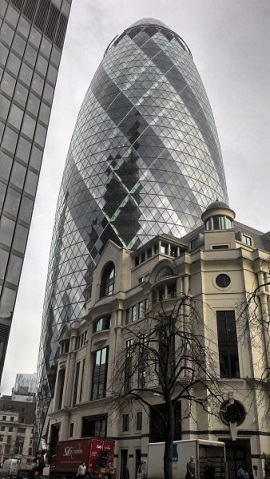30 St. Mary Axe
Contents |
[edit] Introduction
30 St. Mary Axe, widely known as ‘The Gherkin’, is a commercial office building in the heart of the City of London. Since its completion in December 2003, it has become one of the UK’s most distinctive buildings and a symbol of 21st century London.
The building was designed by the architect Norman Foster and Arup Group and was constructed by Skanska.
In 1992, the Provisional IRA exploded a bomb close to the Baltic Exchange which previously stood on the site. The bomb caused substantial damage to the building façade, and despite the intentions of conservation groups such as English Heritage (now Heritage England), the decision was taken to dismantle the building to make way for a new development.
In 1996, Trafalgar House submitted their plans for a Millennium Tower skyscraper, which was abandoned due to concerns about the proposed height of 386 metres being out-of-scale with the City of London at the time.
Foster and Arup then became involved with a new design, and Deputy Prime Minister John Prescott granted planning permission in 2000. Construction began the following year.
[edit] Design and construction
The design has a circular plan, that widens in profile as it rises and then tapers towards the top, giving it the distinctive ‘gherkin’ shape. However, despite the building’s curved glass shape, the only piece of curved glass is the cap at the very top.
The shape of the building reduces the need for reinforcement to stiffen the structure and resist wind loads. Diagonal braces at the perimeter mean the floor space inside the building is free from columns.
Norman Foster’s design was inspired by ideas developed in the 1970s by Buckminster Fuller for a Climatroffice, a concept for a building to have a free-form glass skin in which a microclimate could be sustained.
The building’s ‘diagrid’ structure, a grid of diagonally-interlocking steel elements, means that each successive floor is offset, creating a spiral atrium. Gaps in each floor act as a ventilation system. Warm air is vented out of the building during warm months and drawn into the building during cold months. The energy efficient design of the building means that its consumption is thought to be 50% lower than a typical skyscraper.
[edit] Completion
The building was completed in December 2003 and opened on 28 April 2004, winning that year’s RIBA Stirling Prize in an unprecedented unanimous decision.
The building went on sale in September 2006 for £600 million. In 2007, IVG Immobilien AG and UK investment firm Evans Randall purchased the building for £630 million.
In April 2014, the building was put up for sale again, and in November 2014 was purchased by the Safra Group for £700 million.
With several commercial tenants, the building is only intermittently opened to the public. The top level dome (40th floor) houses a bar for tenants and their guests, and there is a restaurant on the 39th floor and private dining rooms on the 38th.
[edit] Project data:
- Address: St. Mary Axe, London
- Construction period: 2001 – 2003
- Height: 180 m (591 ft)
- Floor count: 41
- Floor area: 47,950 m2 (516,100 sq ft)
- Architect: Foster and Partners
- Developer: Sellar Property Group
- Main contractor: Arup
- Notable prizes: Stirling Prize 2004, First Prize – Emporis Skyscraper Award 2003, London Architecture Biennale – Best New London Building, Civic Trust Award,
[edit] Find out more
[edit] Related articles on Designing Buildings Wiki
- 20 Fenchurch Street.
- BT Tower.
- Buckminster Fuller.
- City Cluster, City of London.
- City Cluster, Kit of Parts.
- City Hall, London.
- Concept architectural design.
- Dancing House, Prague.
- Guggenheim Museum, Bilbao.
- Habitat 67.
- Leadenhall building.
- Lloyd's of London.
- Luxor Las Vegas.
- Nakagin Capsule Tower.
- NatWest Tower
- Norman Foster.
- SIS Building.
- The Shard.
- Tallest buildings in the world.
- Torre Agbar.
[edit] External references
- BrightHub - The Gherkin
- Design Book Mag - Designing the Gherkin
- Foster and Partners
Featured articles and news
Architects, architecture, buildings, and inspiration in film
The close ties between makers and the movies, with our long list of suggested viewing.
SELECT three-point plan for action issued to MSPs
Call for Scottish regulation, green skills and recognition of electrotechnical industry as part of a manifesto for Scottish Parliamentary elections.
UCEM becomes the University of the Built Environment
Major milestone in its 106-year history, follows recent merger with London School of Architecture (LSE).
Professional practical experience for Architects in training
The long process to transform the nature of education and professional practical experience in the Architecture profession following recent reports.
A people-first approach to retrofit
Moving away from the destructive paradigm of fabric-first.
International Electrician Day, 10 June 2025
Celebrating the role of electrical engineers from André-Marie Amperè, today and for the future.
New guide for clients launched at Houses of Parliament
'There has never been a more important time for clients to step up and ...ask the right questions'
The impact of recycled slate tiles
Innovation across the decades.
EPC changes for existing buildings
Changes and their context as the new RdSAP methodology comes into use from 15 June.
Skills England publishes Sector skills needs assessments
Priority areas relating to the built environment highlighted and described in brief.
BSRIA HVAC Market Watch - May 2025 Edition
Heat Pump Market Outlook: Policy, Performance & Refrigerant Trends for 2025–2028.
Committing to EDI in construction with CIOB
Built Environment professional bodies deepen commitment to EDI with two new signatories: CIAT and CICES.
Government Grenfell progress report at a glance
Line by line recomendation overview, with links to more details.
An engaging and lively review of his professional life.
Sustainable heating for listed buildings
A problem that needs to be approached intelligently.
50th Golden anniversary ECA Edmundson apprentice award
Deadline for entries has been extended to Friday 27 June, so don't miss out!
CIAT at the London Festival of Architecture
Designing for Everyone: Breaking Barriers in Inclusive Architecture.
Mixed reactions to apprenticeship and skills reform 2025
A 'welcome shift' for some and a 'backwards step' for others.


























Comments